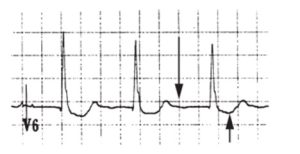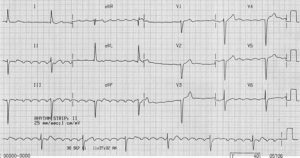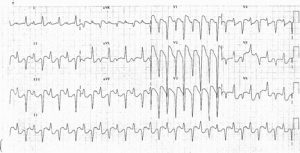Welcome to Digoxin Day, Part 2! Like all sequels, this is sure to be even better than the original.
Cardiac Physiology of Digoxin:
Cardiac glycosides increase parasympathetic tone by acting on the vagus nerve. They also depress myocardial tissue. Together, these actions cause a decreased rate of depolarization through the SA node and a decreased rate of conduction through the AV node. The longer time to depolarization through the SA node leads to a longer PR interval, which contributes to “digitalis effect” (see next paragraph for more on this). The decreased conduction through the AV node encourages automaticity, or the atria and ventricles beating independently of each other.
Recall from yesterday that digoxin increases the amount of available calcium inside the cardiac myocytes. That causes an increased resting potential inside the cells, and shortens the repolarization time. This is reflected on the ECG as a short QT interval. The ST segment looks “scooped out,” causing the well-known “Salvador Dali mustache” morphology known as “digitalis effect.” Remember that seeing digitalis effect on the ECG does NOT imply toxicity – only that the patient takes digoxin.
Digoxin-Associated Arrhythmias:
Digoxin can cause nearly any dysrhythmia. It will never cause a conducted SVT (remember that conduction through the AV node is depressed), but nearly anything else is fair game. These arrhythmias may be complicated, due to digoxin’s dual effects of increased automaticity and decreased conduction through the AV node. Atrial tachycardias, atrial flutter or atrial fibrillation with AV block (see ECG 1 below), PVCs, ventricular bigeminy, ventricular fibrillation, junctional tachycardias, high degree AV blocks, sinus bradycardia, and AV dissociation may all be seen. Bidirectional ventricular tachycardia, while rare, is nearly diagnostic of digoxin toxicity (see ECG 2 below).
ECG 1: Atrial flutter with depressed ventricular rate
ECG 2: Bidirectional ventricular tachycardia
And, as a bonus – mentions of digoxin/foxglove in pop culture:
- “The Rake,” by the Decemberists
- In which a father murders one of his children by “feeding her foxglove”
- “I am Chemistry” by Yeasayer
- In which the lead singer claims he is “digoxin, from the foxglove plant,” and (double bonus!) VX is also mentioned
- The X-Files season 1, episode 11 – “Eve”
- In which Scully realizes that a creepy pair of clone sisters is using foxglove to off their enemies
References:
- Hoffman RS, Howland MA, Lewin NA et al. 65: Cardioactive steroids. In: Goldfrank’s toxicologic emergencies, 10th ed.
- http://lifeinthefastlane.com/ecg-library/basics/digoxin-toxicity/



